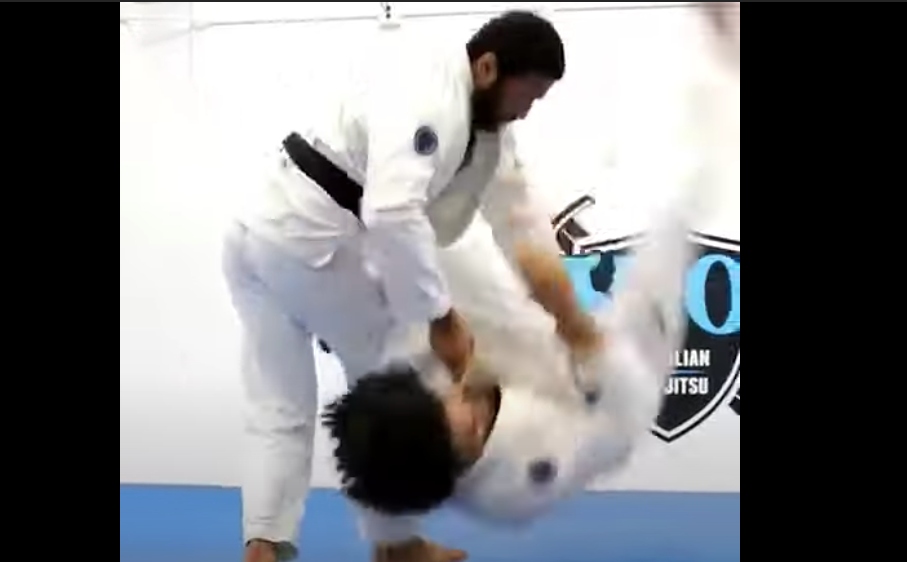Hiza-guruma is the 2nd throw of the Gokyo-no-waza, which makes up the first 40 throws of the Kodokan judo syllabus. The particular variation shown in the attached video is done from a static upright position, so the one throwing (tori) must generate all of the force required to throw his partner (uke) in one simple movement. By “static upright position,” I mean that both practitioners are facing each other in a natural upright stance and not moving around the mat.
Now, Hiza-guruma basically means “knee-block.” The throw operates on a single arc of motion created by your hands and the twisting of your hips and torso. While your upper-body generates the power to drive the throw, you simultaneously block his knee with your foot (If you move your hips and shoulders in a counter-clockwise motion during the throw, you block his right knee with your left foot. If in a clockwise motion, you block his left knee with your right foot.). The idea is not to trip your opponent, but to cause him to flip over his own blocked knee.
Try to keep the leg you use to block his knee straight and stiff, so your opponent is unable to step forward and around you as you pull him into the throw. Pivot your support leg right before you attack, so that the toes on your support leg point to the knee that you will block. This will give you a greater range of motion to move your hips as you throw.
Bonus tip: If you are taller than your partner, you may want to step in a lateral direction away from the leg you will block, so as to allow you more space to block your partner’s knee with a straight leg.
Safety tip: You are NOT kicking your partner’s knee when doing this throw. You place the sole of your foot on or slightly above the knee–but you NEVER kick your partner’s knee. If you or your partner are worried about this, have your partner wear a thick knee pad. When you block your partner’s knee, it is similar to the stiff-arm technique you see used in football games by running backs to prevent tackles. Again, do not kick your partner’s knee.
This throw is thought to be one of the most difficult throws in judo. Some people have joked: “When doing Hiza-guruma, you have to be able to pull a person right out of their socks!” So, don’t be too frustrated if you don’t see results at first. Lots of small adjustments will have to be made as you practice. Like anything worth learning, it takes time, dedication, and hard work. That being said, constant practice of this variation will pay off. A residual benefit of constantly practicing Hiza-guruma is massive grip strength, which will assist you on the ground when going for sweeps and chokes.
If you are not able to flip your partner completely over, as seen in the video, you are probably not pulling hard enough. Now, the one you see throwing in the video is 30 pounds lighter than the one being thrown. Nikolas Collier (black gi) is 149 lbs., while his older brother (blue gi) is 179lb.–so it can be done–even if your partner outweighs you to an extent. If you would like an exercise to improve your Hiza-guruma, then do lots of pull ups.
Getting started: If possible, try to find someone who is your same height and slightly lighter than yourself. This will allow you to concentrate on proper technique, while slowly developing your grips and pulls. Once you start to get the hang of it, you can try a heavier partner. Always practice on a properly matted surface–and even use a crash pad if possible. Always make sure your partner knows how to break fall correctly, so as to avoid the damage that can come with hitting the floor. It’s also not a bad idea for your partner to use a mouthpiece when you throw him / her. Have your partner to tuck his / her chin and to bite down on the mouth piece right before you throw. Because this throw suddenly jerks a person forward, your partner may experience a type of “whiplash” (especially if you throw when your partner is not ready). To avoid a sore neck, it’s a good idea to properly condition your neck muscles for a couple of months before letting someone throw you with Hiza-guruma. Again, tucking your chin before your partner throws you will also protect your neck, as you get started.
Using Hiza-guruma to develop strength: How many times should you do this throw in a practice? After you have warmed up and practiced your break fall, do the throw over and over again until you tire, then try to do five more good reps. How fast you tire will depend on how hard your pull, and will reasonably vary from person to person. Practice the throw in this manner at least twice a week (let’s say Monday and Thursday, for example). If you feel sharp joint pain or dizziness during practice, stop immediately. Proper throwing in practice, should never result in you or your partner becoming injured. Have fun and stay safe!
Judo and BJJ black belt Dominique Bell shows a great Hiza Guruma set up for BJJ:
“If You’re Serious About Learning Takedowns, As Well As Judo, For BJJ– This Is The Most Complete Resource You Will Ever See”
Jimmy Pedro and Travis Stevens’ Judo Academy Teaches Takedowns and Judo Ground Fighting More Extensively Than Any Other Program In American History



















